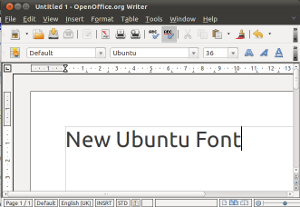- Home
- Learn Linux
- Learn Electronics
- Raspberry Pi
- Programming
- Projects
- LPI certification
- News & Reviews


12 October 2010
I've been using Ubuntu Linux for some time now. I have just bought a new Dell Inspiron laptop a few days before the release of 10.10. I first tried the release client of Kubuntu, but then once the final release was out I installed the release of Ubuntu.
One of the reasons I've been using Ubuntu is that it is so easy to install and use. In the past Linux had a reputation for being difficult to use, but in the last few years that has been completely turned around so that Linux is in many ways easier to use than much of the competition.
Ubuntu is completely free, usually obtained as a free download, although also available via post or on computer magazines (eg. Linux Format).

Install is as simple as booting from CD and answering a few simple questions such as whether to replace or install alongside the current operating system and selecting location. It is better if the computer is connected to the Internet at this point (eg. by plugging into a broadband router) as it can then install any device drivers.
As well as the operating system a selection of standard applications are included including:
As long as you tick the "install proprietary software" button during install you also get the codecs required to play MP3s / play Flash video etc.
The desktop simple menus allowing you to access all the applications that are installed. If you need anymore then there are lots more free applications that can be installed over the Internet through the Ubuntu Software Centre. This is similar to the application installers for Apple iPhones or Google Android phones, but with all the software available for free and being checked for suitability / compatibility by the Ubuntu community team. There should be applications to suit most needs.
There are several different variations of the Ubuntu Linux distribution, but the two I considered for my laptop were the standard Ubuntu (Gnome) and Kubuntu (KDE). I am more familiar with Gnome, but I did try KDE before installing Ubuntu. Some people get very passionate about which window manager they prefer, but I think both are good. Gnome is faster, whereas KDE is a little slower, but still pretty good for a recent computer, if running on older hardware then there are even faster window managers such as Xfce (Xubuntu).
KDE has a lot of eye candy and useful desktop tools called Plasmoids. These are similar to Windows Vista / Windows 7 desktop applets. These look extremely good and can be useful.
In the end I chose to stick with Gnome because I prefer my window manager to be fairly minimalistic and to keep out of the way, but others may prefer the bling provided by KDE.
With a 6 monthly release cycle each release of the Ubuntu operating system tends to have smaller changes than some other operating systems that may go for several years between versions. This means that the operating system is constantly evolving rather than a large change that breaks compatibility and alienates existing users. Despite this there are still some nice new features in Ubuntu 10.10.
One change is the introduction of a new official Ubuntu font which along with a few other cosmetic changes has created a much improved look and feel to the desktop.

I've already mentioned the proprietary software option during install which along with having an Internet connection during install greatly improves the install of the hardware drivers and makes the install simpler.
The file manager has improved handling of overwrite user intervention and there are lots of smaller upgrade versions to the bundled applications.
There is nothing particularly groundbreaking in this version of Ubuntu, but it does continue to build on the success of previous releases to provide a good stable operating system that is easy to use, fast and free. I highly recommend Ubuntu 10.10.